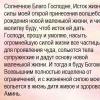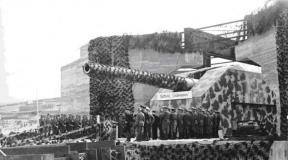When there was a siege of the Turkish fortress Ishmael. Assault on Ishmael - a great victory for the Russian army
On December 24, Russia celebrates the Day of Military Glory of Russia - the Day of the Capture Turkish fortress Ishmael. For more than twenty years the country has been celebrating this memorable date. Back in 1790, Russian troops under the command of Count Alexander Vasilyevich Suvorov stormed the fortress of Izmail, one of the most important defensive points. Ottoman Empire in the Northern Black Sea region.
The lands of the Lower Danube were conquered by the Ottoman Empire at the end of the 15th century. The Ottoman Empire, which had conquered almost all the Black Sea lands by that time, needed to create its own strongholds in the conquered lands. One of these points was the Izmail fortress, the first mention of which dates back to 1590-1592. Although in fact the fortress was probably founded a little earlier. Gradually, Ishmael grew into a small town, and in 1761 the chair of the Metropolitan of Brailov, who ruled the Orthodox churches in the Danubian possessions of the Ottoman Empire, was even established here.
The strategically important position of Izmail explains the increased attention to this fortress from the Russian troops during almost all Russian-Turkish wars of the 18th-19th centuries. The first time Izmail was taken by Russian troops under the command of Lieutenant General Nikolai Repnin on August 5 (July 26, old style) 1770. But after the end of the war, according to the terms of the Kyuchuk-Kaynarji peace treaty, the Izmail fortress was again returned to the jurisdiction of the Ottoman Empire.
Peace between the Russian and Ottoman empires, however, did not last long. Already thirteen years after the end of the Russian-Turkish war of 1768-1774. started new war. The Ottoman Empire was extremely dissatisfied with the terms of the Kyuchuk-Kaynarji peace treaty, according to which the most important vassal of the Port - the Crimean Khanate - received political independence and, therefore, could fall under the influence of Russia. The Ottoman authorities were very afraid of this, so they went for revenge, trying to once again ensure their dominance in the Black Sea region. The situation was aggravated by the fact that Georgia accepted the protectorate of the Russian Empire. Enlisting the support of Great Britain and France, the Ottoman Empire issued an ultimatum to Russia in 1787 - to restore the vassalage of the Crimean Khanate in relation to Porte and to abandon the protectorate of Georgia, as well as agree to searches Russian ships passing through the Bosporus and Dardanelles. Naturally, Russia could not satisfy the demands of the Ottoman Empire.
On August 13 (24), 1787, another Russian-Turkish war began. Like previous wars with the Ottoman Empire, it had both sea and land character. To strike at the Turkish positions in the spring of 1788, two powerful armies were created. The first, Yekaterinoslav, consisted of about 80 thousand soldiers and officers under the command of Grigory Potemkin. She was entrusted with the task of mastering Ochakovo. The second, Ukrainian, numbering 37 thousand soldiers and officers under the command of Rumyantsev, aimed at Bendery. The eastern flanks were to be defended by the troops of General Tekeli, numbering 18 thousand soldiers and officers, who took up positions in the Kuban. However, despite the numerous forces involved in the fighting, the war took on a protracted character. Since a lot has been written about the course of hostilities, let's go directly to the assault on Ishmael.
Field Marshal Grigory Potemkin, who commanded the Russian army, entrusted the capture of this strategically important fortress to General-General Alexander Suvorov, one of the most talented Russian commanders. On December 2, 1790, General-in-Chief Suvorov arrived at the location of the units of the Southern Army, which by this time had approached Izmail, and immediately began preparing to storm the fortress. As you know, Alexander Suvorov paid great attention to the combat training of troops. He applied his approach in this case too, knowing full well that it is better to spend time preparing the troops well for the upcoming assault on the fortress than to suffer heavy losses during the assault due to the untrained soldiers and the lack of coordination between the units.
In the vicinity of Izmail, Suvorov ordered the construction of earthen and wooden copies of the moat, rampart and walls of the Turkish fortress. After that, Suvorov began to train troops. Soldiers were taught to throw a ditch, put up ladders as quickly as possible and climb up the fortress walls with lightning speed. The general-in-chief personally inspected the exercises, observing the level of training of soldiers and officers. Suvorov spent six days preparing for the assault on Izmail. During this time, he not only prepared the personnel of the troops, but also personally traveled along the fortress walls of Izmail, making sure, to his chagrin, that the system of defensive structures of the fortress had practically no flaws.
 On December 7 (18), 1790, General-in-Chief Suvorov sent an ultimatum to the commandant of the fortress, Izmail, in which he demanded to surrender the fortress within 24 hours after the ultimatum was presented. The Turkish pasha indignantly rejected the ultimatum. After that, Suvorov began preparations for a direct assault. The military council, assembled by Suvorov, set the date for the assault on December 11.
On December 7 (18), 1790, General-in-Chief Suvorov sent an ultimatum to the commandant of the fortress, Izmail, in which he demanded to surrender the fortress within 24 hours after the ultimatum was presented. The Turkish pasha indignantly rejected the ultimatum. After that, Suvorov began preparations for a direct assault. The military council, assembled by Suvorov, set the date for the assault on December 11.
To carry out the assault, Suvorov divided his troops into three detachments, each of which, in turn, included three columns. The eastern part of the fortress was to be stormed by the 12,000th detachment of Lieutenant General A.N. Samoilov, the western part - to the 7.5 thousandth detachment of Lieutenant General P.S. Potemkin, and the detachment of Major General I. de Ribas, numbering 9 thousand people, was to take over the river side. In total, more than 31 thousand people, including about 15 thousand people of irregular troops, were to take part in the assault on Izmail from the Russian side. Understanding perfectly well that it is better to strike the first blow in the dark, but to carry out the main assault already in the daytime, Suvorov decided to start the assault at about 5 o'clock in the morning.
Artillery preparation for the assault began on December 10 (21), 1790. From early morning, the flank batteries of the Russian army and the ship's batteries of the ships of the flotilla began shelling Izmail. It lasted a day and stopped 2.5 hours before the Russian troops stormed the fortress. On the night of December 11 (22), 1790, Russian troops left the camp and advanced towards Izmail. The first to storm the 2nd column, commanded by Major General Boris Lassi. His units managed to force the rampart. The actions of the 1st column, commanded by Major General S.L. Lvov. His subordinates - grenadiers and riflemen - were able to capture the first Turkish batteries and take control of the Khotyn Gate. It was a real success.
The soldiers of Lvov opened the Khotyn gates, after which the Russian cavalry rushed into them. In turn, the column of Major General M.I. Kutuzova-Golenishcheva captured the bastion in the area of the Kiliya Gates, after which she established control over a large section of the rampart. It was more difficult for the soldiers and officers from the 3rd column, commanded by Major General Fyodor Meknob. His fighters stormed the northern bastion of the fortress, but the depth of the moat and the height of the rampart were very great in this area. The length of the stairs was not enough to overcome the bastion. I had to tie the stairs in two. However, this difficult task, in the end, was completed. Russian troops took the northern bastion of Ishmael.
At about 7 o'clock in the morning, the landing of the river detachment began, commanded by Major General Deribas. Although the Russian paratroopers were opposed by more than 10 thousand Ottoman soldiers, the landing was also successful. The landing was covered by a column of General Lvov, who struck in the flank, as well as troops operating on the eastern approaches to the fortress. The Kherson rangers, commanded by Colonel Valerian Zubov, the brother of Catherine II's favorite Platon Zubov, showed themselves excellently during the assault. The actions of other units were no less successful, in particular, the battalion of the Livland rangers, commanded by Colonel Roger Damas, was able to capture the battery that controlled coastline. 
However, having broken into Izmail, the Russian troops encountered the most serious resistance from the Turkish-Tatar garrison. The Ottomans were not going to give up without a fight. Defending Turkish and Tatar askers settled in almost every house. In the center of Izmail, a detachment of the Crimean Tatar cavalry, commanded by Maksud Giray, entered into battle with a detachment of Major General Lassi. The battle between the Russian soldiers and the Tatars was fierce, from the detachment of the Tatars, numbering about 1 thousand people, only 300 askers survived. In the end, Maksud Giray was forced to surrender along with the remnants of his unit.
Realizing that street fighting could lead to heavy human losses, General-in-Chief Suvorov decided to use light artillery to neutralize the defenders of Ishmael. 20 light artillery pieces were introduced into the territory of the fortress, which opened fire with grapeshot on the Turkish and Tatar soldiers who were still fighting on the streets of Izmail. Separate groups of Turks, however, even after the artillery shelling, tried to hold the separate, most powerful buildings of Ishmael. Only by 14.00 Russian troops were able to finally establish control over the city center, and two hours later the resistance of the last defenders of Izmail was eliminated. The rare survivors of Turkish and Crimean Tatar soldiers surrendered.
The calculation of losses demonstrated the full scale of the event, which was included in the storming of Ishmael. As a result of the siege of the fortress and the fighting, more than 26 thousand Turkish-Tatar soldiers were killed. More than 9 thousand Turks were taken prisoner, of which about 2 thousand died of wounds the next day, as medical care for such a large number of people was not possible. There were so many corpses of dead Turkish and Tatar soldiers that the Russian command could not even ensure their burial. It was ordered to throw the corpses of the enemy into the Danube, but even this measure made it possible to clear the territory of Ishmael from the corpses only on the sixth day.
The trophies of the Russian army were 265 Turkish artillery pieces, a huge amount of ammunition, auxiliary vessels - 12 ferries and 22 light ships. Russian troops lost a disproportionately smaller number of soldiers and officers than the defenders of the fortress. 64 officers and 1816 lower ranks were killed, 253 officers and 2450 lower ranks were injured. Another 95 people were killed and 278 people were wounded by the Russian fleet, which also participated in the assault on Izmail.
The victory in Izmail was a tremendous success for the Russians. Empress Catherine II generously rewarded General Field Marshal Grigory Potemkin, who received as a reward a field marshal's uniform, embroidered with diamonds and estimated at 200 thousand rubles, and the Tauride Palace. The merits of General-in-Chief Alexander Suvorov were, however, much less appreciated. He received a medal and the rank of lieutenant colonel of the Preobrazhensky regiment (recall that the ranks of lieutenant colonels and colonels of the guards regiments were equated with the highest army general ranks), although there were already ten lieutenant colonels in the Preobrazhensky regiment by this time. The assault on Ishmael has firmly entered the Russian military and army folklore, many songs and legends have been composed about him. He further strengthened the authority of General-in-Chief Suvorov in the troops, becoming another evidence of the military genius of the Russian general.
If we talk about the political consequences of the capture of Ishmael, they were also impressive. When in 1791-1792. between the Russian and Ottoman empires, the Treaty of Jassy was concluded, and the Crimean Khanate finally ceded to the Russian Empire. The border with the Ottoman Empire was established along the Dniester River. Thus, in the composition Russian state included the entire Northern Black Sea region - the territory of the modern south of Ukraine, Crimea and Kuban. Of course, the Ottoman Empire was not going to refuse revanchist plans, but a serious blow was dealt to its positions. However, Ishmael himself, for whom the blood of Russian soldiers was shed, was returned to the Ottoman Empire under the Iasi Treaty. Izmail became part of the Russian state only in 1878, almost a century after his grandiose assault. Then, in 1918-1940, Izmail, like all of Bessarabia, was part of Romania, and then - until 1991 - part of the Ukrainian SSR.
Day of military glory in memory of the assault on Ishmael has for everyone great importance. This is another reason to remember our ancestors, the brave Russian soldiers who shed their blood for their homeland in all the numerous wars and battles.
Victory of the Russian Empire
Assault on Ishmael- siege and assault in 1790 of the Turkish fortress of Izmail by Russian troops under the command of General-General A. V. Suvorov during the Russian-Turkish war of 1787-1792
Suvorov took steps to ensure order. Kutuzov, appointed commandant of Ishmael, posted guards in the most important places. A huge hospital was opened inside the city. The bodies of the killed Russians were taken out of the city and buried according to the church rite. There were so many Turkish corpses that an order was given to throw the bodies into the Danube, and prisoners were assigned to this work, divided into queues. But even with this method, Ishmael was cleared of corpses only after 6 days. The prisoners were sent in batches to Nikolaev under the escort of the Cossacks.

Lettering: "For Outstanding Courage" on the front and "Ishmael taken December 11 1790" on the back.
Suvorov expected to receive the rank of field marshal for the assault on Izmail, but Potemkin, petitioning the empress for his award, offered to award him a medal and the rank of lieutenant colonel or adjutant general of the guard. The medal was knocked out, and Suvorov was appointed lieutenant colonel of the Preobrazhensky regiment. There were already ten such lieutenant colonels; Suvorov became the eleventh. The commander-in-chief of the Russian army, Prince G. A. Potemkin-Tavrichesky, having arrived in St. Petersburg, received as a reward a field marshal's uniform, embroidered with diamonds, worth 200 thousand rubles, the Tauride Palace; in Tsarskoye Selo, it was planned to build an obelisk to the prince depicting his victories and conquests. The lower ranks were given oval silver medals; for officers who did not receive the Order of St. George or Vladimir, a golden cross is installed on the St. George ribbon; chiefs received orders or golden swords, some - ranks.
The conquest of Ishmael was of great political importance. It influenced the further course of the war and the conclusion in 1792 of the Iasi Peace between Russia and Turkey, which confirmed the annexation of Crimea to Russia and established the Russian-Turkish border along the Dniester River. Thus, the entire northern Black Sea region from the Dniester to the Kuban was assigned to Russia.
The victory near Ishmael was dedicated to the hymn “Thunder of victory, resound! ”, which until 1816 was considered the unofficial anthem of the Russian Empire.
Notes
Sources
- A. A. Danilov. History of Russia IX-XIX centuries.
- The team of authors."One hundred great battles", M. "Veche", 2002
Links
- Assault on Ishmael, - from the book. "Kutuzov", Rakovsky L.I. : Lenizdat, 1971
(cousin of the favorite). The commander of the river flotilla was junior in rank, but he did not have the slightest desire to obey the lieutenant generals.
Map of the fortifications of the fortress Ismail - 1790 - Plan of fortress Ismail
Izmail was one of the strongest fortresses in Turkey. Since the war of 1768-1774, the Turks, under the leadership of the French engineer De Lafitte-Clove and the German Richter, have turned Izmail into a formidable stronghold. The fortress was located on a slope of heights sloping towards the Danube. A wide hollow, stretching from north to south, divided Izmail into two parts, of which the large, western, was called the old, and the eastern - the new fortress. The fortress fence of the bastion style reached 6 versts in length and had the shape of a right-angled triangle, with a right angle facing the north, and the base - to the Danube. The main shaft reached 8.5 meters in height and was surrounded by a moat up to 11 meters deep and up to 13 meters wide. The ditch was filled with water in places. There were four gates in the fence: on the western side - Tsargradsky (Brossky) and Khotinsky, on the northeast - Bendersky, on the east - Kiliya. The ramparts were defended by 260 guns, of which 85 guns and 15 mortars were on the river side. The city buildings inside the fence were brought into a defensive state. A large number of firearms and food stocks were prepared. The garrison of the fortress consisted of 35 thousand people. He commanded the garrison of Aydozli-Mahmet Pasha.
Russian troops surrounded Izmail and bombarded the fortress. Seraskir was sent an offer to surrender Ishmael, but received a mocking response. The lieutenant general convened a military council, at which they decided: to lift the siege and retreat to winter quarters. The troops began to slowly withdraw, the de Ribas flotilla remained with Ishmael.
Still not knowing about the decision of the military council. Potemkin decided to appoint general-in-chief Suvorov as commander of the siege artillery. Suvorov was endowed with very broad powers. On November 29, Potemkin wrote to Suvorov: “ ... I leave your excellency to do here at your best discretion, whether by continuing the enterprises to Ishmael or leaving onago.
On December 2, Suvorov arrived at Ishmael. Together with him, a Phanagorian regiment and 150 musketeers of the Apsheron regiment arrived from his division. By December 7, up to 31 thousand troops and 40 field artillery guns were concentrated near Izmail. About 70 guns were in the detachment of Major General de Ribas, located on the island of Chatal opposite Izmail, and another 500 guns were on the ships. The guns of the de Ribas detachment did not go to winter quarters, but remained in their previous seven firing positions. From the same positions, the artillery of de Ribas shelled the city and the fortress of Izmail in the period of preparation for the assault and during the assault. In addition, by order of Suvorov, on December 6, another battery of 10 guns was laid there. Thus, there were eight batteries on Chatal Island.
Suvorov deployed his troops in a semicircle two versts from the fortress. Their flanks rested on the river, where the de Ribas flotilla and the detachment on Chatal completed the encirclement. Reconnaissance was carried out for several days in a row. At the same time, stairs and fascines were prepared. To make it clear to the Turks that the Russians were going to conduct a proper siege, on the night of December 7, batteries for 10 guns each were laid on both flanks, two on the western side, 340 meters from the fortress, and two on the eastern side, 230 meters from the fence. To train the troops in the assault, a ditch was dug to the side and ramparts similar to those of Ishmael were poured. On the night of December 8 and 9, Suvorov personally showed the troops the techniques of the escalade and taught them to operate with a bayonet, and the fascines represented the Turks.
On December 7, at 2 pm, Suvorov sent a note to the commandant of Ishmael: “Seraskir, the foremen and the whole society: I arrived here with the troops. 24 hours for reflection for surrender and will; my first shots are already bondage; storm-death. Which I leave for you to consider." The next day, an answer came from the seraskir, who asked permission to send two people to the vizier for a command and offered to conclude a truce for 10 days from December 9th. Suvorov replied that he could not agree to the request of the seraskier and gave a deadline until the morning of December 10th. At the appointed time, there was no answer, which determined the fate of Ishmael. The assault was scheduled for December 11th.
On the eve of the assault, on the night of December 10, Suvorov gave the troops an order that inspired them and instilled faith in the upcoming victory: “Brave warriors! Bring to your memory all our victories on this day and prove that nothing can resist the power of Russian weapons. We have not a battle to postpone, but an indispensable capture of a famous place, which will decide the fate of the campaign, and which the proud Turks consider impregnable. The Russian army besieged Izmail twice and retreated twice; it remains for us, for the third time, either to win, or to die with glory.” Suvorov's order made a strong impression on the soldiers.
Preparations for the assault began with artillery fire. On the morning of December 10, about 600 guns opened powerful artillery fire on the fortress and continued it until late at night. The Turks responded from the fortress with the fire of their 260 guns, but to no avail. The actions of the Russian artillery proved to be very effective. Suffice it to say that by the evening the artillery of the fortress was completely suppressed and ceased fire. “... At sunrise, from the flotilla, from the island and from four batteries, arranged on both wings on the banks of the Danube, a cannonade opened across the fortress and continued uninterruptedly until the troops took their way to attack. On that day, from the fortress, at first, lively cannon fire was answered, but by noon the firing faded, and by nightfall it was completely stopped and there was silence all night long ... ”.
At 3 p.m. on December 11, the first signal rocket went up, along which the troops lined up in columns and moved to the designated places, and at 5:30 a.m., at the signal of the third rocket, all the columns stormed. The Turks let the Russians into the range of a canister shot and opened fire. The 1st and 2nd columns of Lvov and Lassi successfully attacked the Brossky Gate and the Tabie Redoubt. Under enemy fire, the troops captured the rampart and with bayonets paved the way to the Khotyn Gate, through which cavalry and field artillery entered the fortress. Meknob's 3rd column stopped because in this sector the stairs prepared for the assault were not long enough and they had to be tied in two. With great effort, the troops managed to climb the rampart, where they met stubborn resistance. The situation was saved by the reserve, which made it possible to overturn the Turks from the ramparts into the city. Orlov's 4th Column and Platov's 5th Column achieved success after a fierce battle with the Turkish infantry, which suddenly made a sortie and hit the 4th Column in the tail. Suvorov immediately sent a reserve and forced the Turks to retreat to the fortress. The 5th column was the first to climb the rampart, followed by the 4th.
The 6th column of Kutuzov, which attacked the new fortress, found itself in the most difficult position. The troops of this column, which reached the rampart, were counterattacked by the Turkish infantry. However, all counterattacks were repulsed, the troops captured the Kiliya Gates, which made it possible to strengthen the advancing artillery. At the same time, “the worthy and brave major general and cavalier Golenitsev-Kutuzov was an example to his subordinates with his courage.”
Great success was achieved by the 7th, 8th and 9th columns of Markov, Chepiga and Arseniev. Between Seven and eight o'clock in the evening they landed at the Ishmael fortifications on the Danube. The 7th and 8th columns quickly captured the batteries operating against them on the fortifications. It was more difficult for the 9th column, which was supposed to conduct an assault under fire from the Tabie redoubt. After a stubborn battle, the 7th and 8th columns connected with the 1st and 2nd columns and broke into the city.
The content of the second stage was the struggle inside the fortress. By 11 o'clock in the morning, Russian troops captured the Brossky, Khotinsky and Bendersky gates, through which Suvorov moved reserves into battle. Numerous Turkish garrison continued to resist. Although the Turks did not have the ability to maneuver, and without the support of artillery their struggle was ineffective, they nevertheless fought stubbornly for every street and every house. The Turks “sold their lives dearly, no one asked for mercy, the women themselves rushed brutally with daggers at the soldiers. The frenzy of the inhabitants multiplied the ferocity of the troops, neither sex, nor age, nor rank were spared; blood was pouring everywhere - let us cover the spectacle of horrors with a veil. When it is written like this in documents, it is easy to guess that in fact the population was simply slaughtered.
A well-known innovation was the use of field guns by Russians in street battles. So, for example, the commandant of the fortress Aydozli-Mahmet Pasha sat down in the Khan's palace with a thousand janissaries. The Russians carried out fruitless attacks for more than two hours. Finally, the guns of Major Ostrovsky were delivered, with the fire of which they destroyed the gates. The Phanagorian grenadiers launched an assault, slaughtered everyone inside the palace. Artillery smashed the Armenian monastery and a number of other buildings inside the fortress.
By 4 o'clock in the afternoon the city was completely taken. 26 thousand Turks and Tatars (military personnel) were killed, 9 thousand were taken prisoner. The loss of civilians in those days was customary not to mention. In the fortress, the Russians took 245 guns, including 9 mortars. In addition, another 20 guns were captured on the shore.
Russian losses amounted to 1879 people killed and 3214 wounded. For those times it was a huge loss, but the game was worth the candle. Panic broke out in Istanbul. The Sultan blamed the Grand Vizier Sharif-Hassan Pasha for everything. The head of the unfortunate vizier was put up at the gates of the Sultan's palace.
“No, your grace,” Suvorov replied irritably, “I am not a merchant and I did not come to bargain with you. Reward me. Except God and the Most Merciful Empress, no one can!” Potemkin's face changed. He turned and silently entered the hall. Suvorov is behind him. The general-in-chief filed a combat report. Both walked around the hall, unable to get a word out of themselves, bowed and dispersed. They never met again.
The Russian-Turkish war of 1768-1774 ended with the victory of Russia. The country finally secured access to the Black Sea. But according to the Kyuchuk-Kaynarji agreement, the powerful fortress of Izmail, located at the mouth of the Danube, remained Turkish for the time being.
Political situation
In the middle of the summer of 1787, Turkey, with the support of France, Great Britain and Prussia, demanded from Russian Empire the return of Crimea and the refusal of the Georgian authorities in their patronage. In addition, they wanted to get consent to the inspection of all Russian merchant ships moving through the straits of the Black Sea. Without waiting for a positive response to their claims, the Turkish government declared war on Russia. It happened on August 12, 1787.
The challenge was accepted. The Russian Empire, in turn, hastened to take advantage of the current situation and increase its possessions at the expense of lands in the Northern Black Sea region.
Initially, Turkey planned the capture of Kherson and Kinburn, the landing of a large number of its troops on the Crimean Peninsula, as well as the destruction of the base of the Russian Black Sea squadron in Sevastopol.
balance of power
In order to deploy full-scale military operations on the Black Sea coast of the Kuban and the Caucasus, Turkey turned its main forces in the direction of Anapa and Sukhum. She had a 200,000-strong army and a fairly strong fleet, consisting of 16 frigates, 19 ships of the line, 5 bombardment corvettes, as well as many other ships and support ships.
In response, the Russian Empire began to deploy its two armies. The first of them is Yekaterinoslavskaya. It was commanded by Field Marshal Grigory Potemkin. It numbered 82 thousand people. The second was the Ukrainian 37,000-strong army under the command of Field Marshal Pyotr Rumyantsev. In addition, two powerful military corps were stationed in the Crimea and Kuban.
As for the Russian Black Sea Fleet, it was based in two places. The main forces, consisting of 23 warships with 864 guns on board, were stationed in Sevastopol and were commanded by Admiral M. I. Voinovich. An interesting fact is that at the same time the future great admiral F.F. Ushakov also served here. The second place of deployment was the Dnieper-Bug Estuary. A rowing flotilla was stationed there, consisting of 20 small-tonnage vessels and ships that were only partially armed.
Allied plan
It must be said that the Russian Empire was not left alone in this war. On her side was one of the largest and strongest European countries at that time - Austria. She, like Russia, sought to expand her borders at the expense of other Balkan countries that were under the yoke of Turkey.
The plan of the new allies, Austria and the Russian Empire, was exclusively offensive. The idea was to attack Turkey from two sides at the same time. The Yekaterinoslav army was supposed to start hostilities on the Black Sea coast, capture Ochakov, then cross the Dnieper and destroy Turkish troops in the area between the Prut and Dniester rivers, and for this it was necessary to take Bendery. At the same time, the Russian flotilla, with its active actions, fettered enemy ships on the Black Sea and did not allow the Turks to land on the Crimean coast. The Austrian army, in turn, promised to launch an offensive from the west and storm Hatin.

Development of events
The beginning of hostilities for Russia was very successful. The capture of the Ochakov fortress, two victories by A. Suvorov at Rymnik and Forshany indicated that the war should end very soon. This meant that the Russian Empire would sign a peace favorable to itself. Turkey at that time did not have such forces that could give a serious rebuff to the allied armies. But politicians for some reason missed this favorable moment and did not take advantage of it. As a result, the war dragged on, as the Turkish authorities were still able to raise a new army, as well as receive help from the West.
During the military campaign of 1790, the Russian command planned to capture the Turkish fortresses located on the left bank of the Danube, and then move their troops further.
This year, Russian sailors under the command of F. Ushakov won one brilliant victory after another. Near the island of Tendra and the Turkish fleet suffered a crushing defeat. As a result, the Russian flotilla firmly established itself on the Black Sea and provided favorable conditions for the further advance of its armies on the Danube. The fortresses of Tulcha, Kiliya and Isakcha had already been taken when Potemkin's troops approached Izmail. Here they met fierce resistance from the Turks.
impregnable citadel
The capture of Ishmael was considered impossible. Before the war, the fortress was thoroughly rebuilt and fortified. It was surrounded by a high rampart and a fairly wide moat filled with water. The fortress had 11 bastions, where 260 guns were placed. The work was supervised by German and French engineers.
Also, the capture of Ishmael was considered unrealistic, because it was located on the left bank of the Danube between two lakes - Katlabukh and Yalpukh. It towered on the slope of a sloping mountain, which at the riverbed ended in a low but steep slope. This fortress was of great strategic importance, since it was located at the intersection of roads from Khotyn, Chilia, Galati and Bendery.
The garrison of the citadel consisted of 35 thousand soldiers, commanded by Aydozle Mehmet Pasha. Some of them reported directly to Kaplan Gerai, the brother of the Crimean Khan. He was assisted by his five sons. The new decree of Sultan Selim III stated that if the capture of the Izmail fortress took place, then every warrior from the garrison would be executed, wherever he was.

Appointment of Suvorov
Russian troops camped under the citadel had a hard time. The weather was wet and cold. The soldiers warmed themselves by burning reeds in fires. Food was sorely lacking. In addition, the troops were in constant combat readiness, fearing attacks by the enemy.
Winter was just around the corner, so the Russian military leaders Ivan Gudovich, Joseph de Ribas and Potemkin's brother Pavel gathered on December 7 for a military council. On it, they decided to lift the siege and postpone the capture of the Turkish fortress of Izmail.
But Grigory Potemkin did not agree with this conclusion and canceled the decision of the military council. Instead, he signed an order that General-in-Chief A. V. Suvorov, who was standing with his troops at Galati, should take command of the army that was besieging the now impregnable citadel.
Preparing for the assault
The capture of the Izmail fortress by Russian troops required the most careful organization. Therefore, Suvorov sent his best Phanagoria grenadier regiment, 1 thousand Arnauts, 200 Cossacks and 150 hunters who served in the Apsheron Musketeer Regiment to the walls of the bastion. He did not forget about the marketers with a supply of food. In addition, Suvorov ordered to put together and send 30 ladders and 1 thousand fascines to Izmail, and also gave the rest of the necessary orders. He handed over the command of the remaining troops stationed near Galati to lieutenant generals Derfelden and Prince Golitsyn. The commander himself left the camp with a small convoy, consisting of only 40 Cossacks. On the way to the fortress, Suvorov met the retreating Russian troops and turned them back, as he planned to use all his forces at the moment when the capture of Ishmael began.

Upon arrival at the camp, located near the fortress, he first of all blocked the impregnable citadel from the Danube River and from land. Then Suvorov ordered the artillery to be positioned as it was done during a long siege. Thus, he managed to convince the Turks that the capture of Ishmael by the Russian troops was not planned in the near future.
Suvorov conducted a detailed acquaintance with the fortress. He and the officers accompanying him drove up to Ishmael at a distance of a rifle shot. Here he indicated the places where the columns would go, where exactly the assault would be carried out and how the troops should help each other. For six days, Suvorov prepared to take the Turkish fortress of Izmail.
The general-in-chief personally traveled to all the regiments and talked with the soldiers about previous victories, while not hiding the difficulties that awaited them during the assault. So Suvorov prepared his troops for the day when the capture of Ishmael would finally begin.
Storm from the land
At 3 am on December 22, the first signal flare caught fire in the sky. This was a conventional sign, according to which the troops left their camp, reorganized into columns and headed to the pre-appointed locations. And by half past six in the morning they moved to take the fortress of Ishmael.
The column led by Major General P.P. Lassi was the first to approach the walls of the citadel. Half an hour after the start of the assault, under a hurricane hail of enemy bullets raining down on their heads, the rangers overcame the rampart, at the top of which a fierce battle ensued. Meanwhile, the Phanagoria grenadiers and Apsheron riflemen under the command of Major General S. L. Lvov managed to capture the first enemy batteries and the Khotyn Gate. They also managed to connect with the second column. They opened the Khotinsky gate for the entry of cavalry. This was the first major victory for the Russian troops since the capture of the Turkish fortress of Izmail by Suvorov began. Meanwhile, in other sectors, the assault continued with increasing force.

At the same time, on the opposite side of the citadel, the column of Major General M. I. Golenishchev-Kutuzov captured the bastion, located from the side of the Kiliya Gates and the rampart adjacent to it. On the day of the capture of the Izmail fortress, perhaps the most difficult task was the goal set for the commander of the third column, Major General F. I. Meknoba. She was supposed to storm the northern large bastion. The fact is that in this area the height of the shaft and the depth of the ditch were too great, so the stairs about 12 m high turned out to be short. Under heavy fire, the soldiers had to tie them up in twos. As a result, the northern bastion was taken. The rest of the ground columns also did an excellent job.
water assault
The capture of Izmail by Suvorov was thought out to the smallest detail. Therefore, it was decided to storm the fortress not only from the land side. Seeing the prearranged signal, the landing troops, led by Major General de Ribas, covered by the rowing fleet, moved towards the fortress and lined up in two lines. At 7 o'clock in the morning they began their landing on the shore. This process went very smoothly and quickly, despite the fact that they were resisted by more than 10 thousand Turkish and Tatar soldiers. This success of the landing was largely facilitated by Lvov's column, which at that time attacked the enemy coastal batteries from the flank. Also, significant forces of the Turks pulled over the ground forces operating from the eastern side.
The column under the command of Major General N. D. Arsenyev swam to the shore on 20 ships. As soon as the troops landed on the shore, they immediately divided into several groups. The Livland chasseurs were commanded by Count Roger Damas. They captured the battery enfilating the shore. The Kherson grenadiers, led by Colonel V. A. Zubov, managed to take a rather tough cavalier. On this day, the capture of Ishmael, the battalion lost two-thirds of its composition. The rest of the military units also suffered losses, but successfully captured their sections of the fortress.

Final stage
When dawn came, it turned out that the rampart had already been captured, and the enemy had been driven out of the fortress walls and was retreating deep into the city. Columns of Russian troops, located from different sides, moved towards the city center. New battles broke out.
The Turks offered especially strong resistance until 11 o'clock. The city was on fire here and there. Thousands of horses, rushing out of the burning stables in a panic, rushed through the streets, sweeping away everyone in their path. Russian troops had to fight for almost every house. Lassi and his detachment were the first to reach the city center. Here Maksud Gerai was waiting for him with the remnants of his troops. The Turkish commander stubbornly defended himself, and only when almost all of his soldiers were killed did he surrender.
The capture of Izmail by Suvorov was coming to an end. In order to support the infantry with fire, he ordered light guns firing grapeshot to be delivered to the city. Their volleys helped to clear the streets from the enemy. At one o'clock in the afternoon it became clear that the victory had actually already been won. But the fighting still continued. Kaplan Geray somehow managed to gather several thousand Turks and Tatars on foot and on horseback, whom he led against the advancing Russian detachments, but was defeated and killed. His five sons also died. At 4 p.m., the capture of the Izmail fortress by Suvorov was completed. The citadel, previously considered impregnable, fell.

Results
The capture of Izmail by the troops of the Russian Empire radically affected the entire strategic situation. The Turkish government was forced to agree to peace negotiations. A year later, both parties signed an agreement under which the Turks recognized Russia's rights to Georgia, Crimea and Kuban. In addition, Russian merchants were promised benefits and all kinds of assistance from the defeated.
On the day of the capture of the Turkish fortress of Izmail, the Russian side lost 2136 people killed. They included: soldiers - 1816, Cossacks - 158, officers - 66 and 1 foreman. There were a few more wounded - 3214 people, including 3 generals and 253 officers.
The losses on the part of the Turks seemed simply huge. More than 26,000 people were killed alone. About 9 thousand were taken prisoner, but the next day 2 thousand died from their wounds. It is believed that only one person from the entire Izmail garrison managed to escape. He was slightly wounded and, falling into the water, managed to swim across the Danube on a log.
Exactly 220 years ago, in December 1790, during the Russian-Turkish war, the impregnable fortress of Izmail was taken.
Map of Ishmael.
Izmail - the stronghold of the Ottoman Porte on the Danube banks - was rebuilt under the guidance of French and German engineers as an army fortress: "horde of kalesi". It was designed to accommodate an entire army. From three sides (northern, western and eastern) the fortress was surrounded by a shaft 6 km long, up to 8 meters high with earthen and stone bastions. In front of the rampart, a ditch 12 meters wide and up to 10 meters deep was dug, which in some places was filled with water. From the south, Ishmael was covered by the Danube. Inside the city there were many stone buildings that could be actively used for defense. The garrison of the fortress consisted of 35 thousand people with 265 fortress guns. Ishmael's commandant was an experienced Turkish military commander, Aydos Mehmet Pasha.
Ishmael was a bone in the throat or the main diamond in the crown. He bothered and did not give up. On the whole, the campaign launched in 1787 was going well. Ishmael was to become a decisive point, the most weighty argument in the conduct of peace negotiations. And, as always happens in such cases, the case stalled.
In November, the Russian army of 31 thousand people (including 28.5 thousand infantry and 2.5 thousand cavalry) with 500 guns laid siege to Izmail from land. The river flotilla under the command of General Horace de Ribas, having destroyed almost the entire Turkish river flotilla, blocked the fortress from the Danube.
Two assaults on Ishmael ended in failure and the troops moved on to a systematic siege and artillery shelling of the fortress. With the onset of autumn bad weather, mass diseases began in the army, located in open areas. Having lost faith in the possibility of taking Ishmael by storm, the generals in charge of the siege decided to withdraw the troops to winter quarters. Everyone surrendered except de Ribas. He did not even think of withdrawing his troops. The last Russian-Turkish company was happy for him.

Joseph Mikhailovich de Ribas.
Brigadier de Ribas is assigned to command a small flotilla of gunboats. The romantic name "gunboat" meant a deckless rowboat, the armament of which consisted of a single bow cannon. But under the command of the active and enterprising Ribas, it was the detachment of gunboats that scattered the Turkish fleet that had broken through into the Dnieper estuary, thus defending the shipyards in Kherson.
In November 1788, Ribas' gunboats supported the landing of the Black Sea Cossacks with fire during the assault on the fortified Berezan, the capture of which ensured a complete blockade of Ochakov, which ultimately allowed him to be taken.
"To facilitate the actions of Your Imperial Majesty's land troops, I ordered the Black Sea flotilla Grebnon under the command of Mr. Major General Ribas, adding boats of faithful Black Sea Cossacks to enter the Danube ... In order to take possession of the batteries at the mouth of this Girl, consisting of he sent a landing of a thousand Granoders of the Dniester coastal When the ships approached the shore, the zeal of Your Imperial Majesty's troops intensified excessively, but the zeal of Your Imperial Majesty's troops was such that they, neglecting life, threw themselves into the water and, keeping one weapon swimming, reached the shore in this case, it was impossible to land more than six hundred people. and the cavalier de ribas, seeing that the enemy had already begun to open it and that the flotilla, in the face of the wind, could not be of help to him, went to attack the batteries during the march, the enemy, hiding in the reeds, fired at him with rifle fire, to which he did not answer, trying to open him, to drive and together with him ascend to the baht are you...
At dawn, Lieutenant Colonel de Ribas sent a detachment on the remaining Turkish boats, to occupy the western battery, this was done very quickly, and successfully, because the enemy left the battery without long-range resistance and ran into the reeds. seven transport ships were taken here; there are thirteen guns on the batteries, and six on the blown up ship; also a few shells and food supplies." (From the report of G. Potemkin to Catherine II)
It is de Ribas who comes up with the brilliant idea to replenish the fleet with flooded Turkish ships raised from the bottom of the estuaries. This is very important because sea ships with a large draft could not conduct combat operations in the shallow coastal strip, estuaries and estuaries, and there was a catastrophic lack of galley and rowing ships.
In June 1789, commanding a separate detachment - the "vanguard" of Gudovich's army, de Ribas stormed the fortified Gadzhubey (here Odessa would later be laid by his efforts), and on November 4, already as commander of the Dnieper rowing flotilla, he took part in the capture of Bendery.
On his account, participation in the famous battle at Cape Tendra, the capture of the fortresses of Tolchi and Isakchi.
"At dawn on the 7th day, the flotilla approached Tulcea. The castle was occupied by the Granoders under the command of Lieutenant Colonel de Ribas. In addition to the recaptured yesterday, the military Vessel got one. Transport and other small thirty-eight guns were found in the castle, ten gunpowder two hundred and forty barrels and a considerable number of different military shells. The entire coast in front of the tulcha was covered with members of torn enemy ships. The Turks killed were considered more than a hundred. We did not lose a single person. "(From the report of G. Potemkin to Catherine II)
"After the defeat and destruction of the enemy ships at tulcha and the capture of this City, the flotilla of Your Imperial Majesty, having risen to Cape Chatal, took its position there, which prevented all communication with the right bank of the Danube from there. General Major Ribas detached two divisions to Isacchi under the command of the fleet of Captain Lieutenant Litke and Lieutenant Colonel Deribas, following with great difficulty up the river against Strong Aspiration, they finally reached to Isaccea 13 of this month. The enemy met them with a cruel cannonade both from the Dry Route and from the flotilla, consisting of one saitia, one Kirlangich and thirteen 2 lansons. But when our detachment, approaching half a cannon shot, opened its cruel continuous fire and set fire to the enemy flotilla, some of our ships bypassed the opposite isacce Island, we went to her rear, then the enemy, completely confused, sought salvation in the Flight, abandoning his ships, the embankments of the battery and the vast castle, which was immediately occupied by the troops landed on the embankment. a lot of supplies, tools of all kinds, ropes, canvases, anchors and a significant amount of gunpowder were found. "(From G. Potemkin's report to Catherine II)
His flotilla, together with the flotilla of the Black Sea Cossacks, and also landing troops landed on lansons (which, by the way, are commanded by his brother Emmanuel), destroyed a significant part of the Turkish Danube fleet (about 200 ships in total), captured cannons, extensive warehouses along the banks of the Danube with food and military equipment, making it difficult to supply the besieged Ishmael. For this, he added St. George of the 2nd class to the orders he already had. The award was given on the personal order of the Empress.
Ribas was getting close to Ishmael. He believed in his military happiness. And suddenly the order is to move to winter quarters.
"When Ishmael was surrounded by strong troops, considering the last testimony of this month, who fled from there on the 8th of NN, about the number of garrison and artillery, and more about the points of defense of the fortress, excellent in that more former, they agreed: as there is no siege artillery, except for naval guns on the squadron and field artillery has one set of charges, and for its close shots, the batteries arranged from the flanks of the fortress are unreliable, when severe winter weather approaches and the distance to the winter quarters is already close, inflict the last blows on river batteries and then proceed to the assault.But how successful this is doubtful, and although followed, then there could be several thousand troops, which for the sake of it should be submitted to the high consideration of His Serene Highness the Commander-in-Chief. According to these difficulties, if there is no assault, then according to military rules, the encumbrance should be changed into a blockade, as the garrison has food only for a month and a half; the necessary parts of the troops for that determined sufficient provisions as well as enough firewood n and porridge and for heating with other necessary benefits for standing.
To this, favorable measures must be taken. According to the strength of the military regulations of the head .... paragraph ...."
Ribas bombarded Potemkin with letters and campaign plans.

Grigory Aleksandrovich Potemkin, Field Marshal General, Commander of the Southern Army.
Maybe this would not have helped, but he had a powerful ally ... Catherine the Second. She understood that if she did not do away with Turkey now, then in the spring the European powers would come out on her side. Potemkin could not stand it - he gave in and sent a letter ... to Alexander Suvorov, whose military glory shone, eclipsing the merits of others with its hot rays. The legendary defense of the Kinburg Fortress, the no less legendary battle at Rymnik, the victory at Focsani - these are only the affairs of the last campaign.

V. Surikov. Portrait of A.V. Suvorov
“Ishmael remains the enemy’s nest, and although the message is interrupted through the flotilla, he still ties his hands for the further enterprises, my hope is in God and in your courage, hurry up, my gracious friend. According to my order to you, your personal presence there will connect all the parts.
There are many tamos of equal rank Generals, and from that there always comes a kind of indecisive Diet. Rybas will be of benefit to you in everything, both in terms of enterprise and diligence. You will be satisfied with Kutuzov; look at everything and arrange it, and praying to God, take it; there are weaknesses, just to go together.
Give instruction to Prince Golitsyn when God helps him go higher, on the original it is signed:
most faithful friend and most obedient servant Prince
Potemkin-Tavrichesky.

Grenadier (presumably of the Yekaterinoslav regiment) 1790s. From an etching by Jacquemart in the 1790s.
Potemkin abdicated responsibility. "Before my orders reached Mr. General Anshef Gudovich, General Lieutenant Potemkin and General Major de Ribas to entrust you with commands over all the troops located near the Danube, and to carry out an assault on Izmail, they decided to retreat. I receive this hour about report, I leave it to your Siya-vu to do here at your best discretion whether by continuing the enterprises on Ishmael or leaving it.Your Siya-in being in place and having your hands untied, of course, do not miss anything that can only contribute to the benefit of service and the glory of weapons. Hurry only to let me know about the measures you accept and provide the aforementioned Generals with your instructions. Suvorov had to decide for himself how to proceed. What, in fact, General Forward, as the Austrian allies would later call him, could decide - of course, an assault. Although, there was definitely a risk. “Such an assault could only be ventured once in a lifetime.” But Suvorov's risk was never thoughtless. As soon as he appeared in the camp with his proven Phanagorians and Apsheronians, the mood in the troops changed. The magic of the name began to work - Suvorov is with us, so everything will be fine. Work began to boil: weapons were checked, ladders were prepared, fascines were knitted.

A training ground was set up: walls and ramparts similar to those of Izmail, where assault techniques were practiced. "More sweat - less blood"

Soldiers of the consolidated grenadier battalions of the Yekaterinoslav army, armed with cavalry carbines and edged weapons on the poles, knives on Ratovishchi.
On December 7, Suvorov sent Potemkin's letter to commandant Ishmael with an ultimatum to surrender the fortress.
“Bringing the troops closer to Ishmael, and surrounding this city on all sides, I already took decisive measures to subdue Him.
Fire and sword are already ready to exterminate every breathing creature in it; but before these pernicious means are used, following the mercy of my most merciful Monarchini, who abhors the shedding of human blood, I demand from you the voluntary surrender of the city. In this case, all the inhabitants and troops of the Ishmael Turks of the Tatars and others, according to the Mohammedan law, will be released beyond the Danube with their estate, but if you continue useless perseverance, then the fate of Ochakov will follow with the city, and then the blood of innocent wives and babies will remain on your answer.
The brave General Count Alexander Suvorov Rymniksky was appointed to carry out this.
Attached to the letter was a note by Suvorov to Seraskir, the Elders and the whole society: “I arrived here with the army.
The Turks first asked for a day for reflection, and then answered no less figuratively: "The Danube will soon stop in its course and the sky will bow to the ground, than Ishmael will surrender."
The assault was scheduled for December 11th. Suvorov had time everywhere, he felt completely in his element - a worthy opponent, a completely impregnable fortress, and he was finally alone. Not a single adviser-chief behind him. Under Kozludzha, Kamensky "hung" in his arms, under Focsani and Rymnik he had to reckon with Prince Coburg. He didn't miss a single detail. A detailed plan was drawn up, columnists were appointed, and reconnaissance was carried out.

Private and chief officer of an infantry regiment in the form of 1786-1796
It was decided to attack in three detachments (three columns each). De Ribas was ordered to attack from the river side (three columns - Major General Arsenyev, Brigadier Chepega and Guards Major Markov). The right wing under the command of Lieutenant General P. S. Potemkin (7500 people - three columns of Major Generals Lvov, Lassi and Meknob) was supposed to strike from the western part of the fortress; the left wing of Lieutenant General A.N. Samoilov (12 thousand people, three columns of brigadiers Orlov, Platov and Major General Golenishchev-Kutuzov) - from the east. Brigadier Westfalen's cavalry reserves (2,500 men) were on the land side. In total, Suvorov's army numbered 31 thousand people, including 15 thousand - irregular, poorly armed.
On December 10 (December 21), at sunrise, preparations began for an assault by fire from the flank batteries, from the island, and from the ships of the flotilla (about 600 guns in total).

O. Vereisky. Suvorov and Kutuzov before the assault on Izmail.
It lasted almost a day and ended 2.5 hours before the start of the assault. At 3 am on December 11 (December 22), the first signal flare went up, along which the troops left the camp and, reorganizing into columns, marched to the designated distance places.

Map of the actions of Russian troops during the assault on Izmail.
At half past six in the morning, the columns moved to attack. Was there fear or excitement? Of course, but there was no panic, everyone knew where he should stand and what to do. Ahead were arrows (they had to stop at the moat and suppress the defenders with fire) and carts with ladders and fascines - to throw the moat.

The Turks heard: furious fire opened from the bastions and ramparts - rifle bullets, buckshot, cannonballs ... Jaegers and grenadiers climbed over the ditch under the walls of the fortress along shaky slippery fascines. Stones and logs were flying from above, but for artillery it was a dead zone. Here at the walls one could take a breath. Wait for the stairs and - upstairs. Ahead were the most experienced of those who stormed Ochakov and survived. The Janachari screeched on the walls, brandishing their short, curved sabers.

Above, bayonets went into action.

Russians foot soldiers during hand-to-hand combat
Suvorov himself was on the north side, not far from the third column.

Casket. Lacquer miniature. N.M. Zinoviev. Capture of Ishmael by Suvorov.
At 6 o'clock in the morning, under a hail of enemy bullets, the huntsmen Lassi overcame the rampart, and a fierce battle ensued above. The Apsheron riflemen and Phanagoria grenadiers of the 1st column of Major General S. L. Lvov overturned the enemy and, having captured the first batteries and the Khotyn Gate, joined with the 2nd column. Khotyn gates were open to cavalry.

Engraving by S. Shiflyar "Storm of Ishmael on December 11 (22), 1790". Made according to a watercolor drawing by the famous battle painter M.M. Ivanova The drawing was based on sketches from nature made by the artist during the battle.
At the same time, at the opposite end of the fortress, the 6th column of Major General M.I. Golenishchev-Kutuzov captured the bastion at the Kiliya Gates and occupied the rampart up to the neighboring bastions. The 4th and 5th columns were not so lucky, they consisted of dismounted Cossacks with shortened peaks, and the fifth was exclusively made up of Cossack recruits; both columns were subordinate to Major General Bezborodko. Pikes were easily cut by Turkish sabers, and the Cossacks were practically unarmed in front of the enemy. Taking advantage of the confusion, the Turks opened the Kilik gates and hit the attackers on the flank. And if it weren’t for help from the reserves, the Cossacks would have had a very difficult time.

Fragment of the diorama "Storm of Ishmael". Izmail Historical Museum of A.V. Suvorov
Difficulties also arose at Meknob's 3rd column: it stormed the large northern bastion, adjacent to it to the east, and the curtain wall between them. In this place, the depth of the ditch and the height of the shaft were so great that the ladders of 5.5 sazhens (about 11.7 m) turned out to be short, and it was necessary to tie them two together under fire. The main bastion was taken. The fourth and fifth columns (respectively, Colonel V.P. Orlov and Brigadier M.I. Platov) also completed the tasks assigned to them, overcoming the rampart in their areas.
And what about de Ribas? His landing troops disembarked at about 7 am.

At the very beginning, the first ground assault column, which took possession of several Danube batteries and thereby facilitated the landing of troops, contributed to the quick and successful course of the attack.
The Turks were shot down from the river side just as successfully as from the land side, and Ribas entered into contact with the columns of Lvov and Kutuzov.
Storm of Ishmael.
By 11 am, Russian flags were flying over almost all the bastions and curtain walls. The most terrible thing began - fighting in the city. For every street, for every house. Cruel, bloody, merciless. Several thousand horses broke out of the stables and rushed around the city in horror, increasing the general confusion. General Lassi was the first to reach the middle of the city, here he met a thousand Tatars under the command of Maksud Giray, prince of Genghis Khan's blood. Maksud Giray defended stubbornly, and only when most of his detachment was killed, he surrendered with 300 soldiers who survived. Behind Lassi, others began to gradually approach the center. To support the infantry and ensure success, Suvorov ordered 20 light guns to be brought into the city in order to clear the streets of the Turks with grapeshot. By one in the afternoon, the whole city was occupied; the Turks continued to defend themselves only in the mosque, two khans and the Tabiya redoubt, but they could not hold out for a long time and were partly driven out, partly surrendered.
Suvorov ordered the cavalry to finally clear the streets. It took time for the execution of this order; individuals and small crowds defended themselves like mad, while others hid, so that one had to dismount to look for them. An attempt to snatch back Ishmael was made by Kaplan Giray, the brother of the Crimean Khan. He gathered several thousand cavalry and foot Tatars and Turks and led them to meet the advancing Russians. But this attempt failed, he fell, more than 4 thousand Turks were killed, including the five sons of Kaplan Giray. At two o'clock in the afternoon all the columns entered the city center. At 4 o'clock the victory was finally won. Ishmael fell. The fortress was taken by an army that was inferior in number to its garrison. The case is extremely rare in the history of military art.

A. Rusin. Entrance A.V. Suvorov in Izmail.
“... there is no stronger fortress, more desperate than defense, like Ishmael, who fell before the highest throne of Her Imperial Majesty by a bloody assault. I sincerely congratulate your lordship ”(From the report of A.V. Suvorov to G.A. Potemkin)

R. Volkov. Portrait of M.I. Kutuzov
According to the promise made by Suvorov in advance, the city, according to the custom of that time, was given to the conquerors for three days. They got rich trophies. Suvorov, as always, did not touch anything. He even refused the magnificent horse in luxurious dress brought to him. “The Don horse brought me here, and I will leave here on it.” At the same time, Suvorov took measures to ensure order. Kutuzov, who had been appointed Izmail's commandant even at the height of the battle (in such a peculiar way Suvorov "stimulated" the 6th column to exploits), posted guards in the most important places. A huge hospital was opened inside the city. The bodies of the killed Russians were taken out of the city and buried according to the church rite. There were so many Turkish corpses that an order was given to throw the bodies into the Danube, and prisoners were assigned to this work, divided into queues. But even with this method, Ishmael was cleared of corpses only after 6 days. The prisoners were sent in batches to Nikolaev under the escort of the Cossacks.

Medal for the lower ranks for take Ishmael.
The awards "for the cause" were distributed, as always, bizarrely. Suvorov expected to receive the rank of field marshal for the assault on Izmail, but Potemkin, petitioning the empress for his award, offered to award him a medal and the rank of lieutenant colonel or adjutant general of the guard.

Award officer's cross for take Ishmael.
The medal was knocked out, and Suvorov was appointed lieutenant colonel of the Preobrazhensky regiment. There were already ten such lieutenant colonels; Suvorov became the eleventh. Obviously, Grigory Alexandrovich did not forgive Alexander Vasilyevich either for his military talent or for his bold phrase. In response to Potemkin's question: "How can I reward you, Alexander Vasilyevich?" Suvorov replied: "I am not a merchant and did not come here to bargain; except God and the Empress, no one can reward me." The commander-in-chief of the Russian army, Prince G.A. Potemkin-Tavrichesky, having arrived in St. Petersburg, received as a reward a field marshad's uniform, embroidered with diamonds, at a cost of 200 thousand rubles. Tauride Palace; in Tsarskoye Selo, it was planned to build an obelisk to the prince depicting his victories and conquests. The lower ranks were given oval silver medals; a gold badge was installed for officers; the chiefs, according to a very detailed and fair report by Suvorov, received orders or golden swords, some received ranks.

8 - Officer's cross and soldier's medal for participation in the assault on Izmail in December 1790
9 - Officer's breastplate of the Phanagoria Grenadier Regiment with the image of the Ishmael Cross. 19th century
The conquest of Ishmael was of great political importance. It influenced the further course of the war and the conclusion in 1791 of the Iasi peace between Russia and Turkey, which confirmed the annexation of Crimea to Russia and established the Russian-Turkish border along the river. Dniester. Thus, the entire northern Black Sea region from the Dniester to the Kuban was assigned to Russia.

Portrait of A.V. Suvorov. Hood. Yu.Kh. Sadilenko
Vesuvius is spitting fire
A pillar of fire stands in the darkness,
Crimson glow gapes,
Black smoke billows upwards.
Pale Pont, roaring thunder ardent,
Blows are followed by blows,
The earth trembles, a rain of sparks flows,
Rivers of rye lava are bubbling, -
Oh Ross! This is your image of glory
That the light ripened under Ishmael.
G. Derzhavin. "Ode on the Capture of Ishmael"
Used materials from Wikipedia and sites.



















